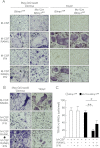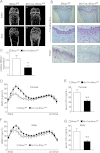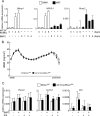Conditional inactivation of Blimp1 in adult mice promotes increased bone mass
- PMID: 22761448
- PMCID: PMC3436583
- DOI: 10.1074/jbc.M112.356634
Conditional inactivation of Blimp1 in adult mice promotes increased bone mass
Abstract
Bone resorption, which is regulated by osteoclasts, is excessively activated in bone destructive diseases such as osteoporosis. Thus, controlling osteoclasts would be an effective strategy to prevent pathological bone loss. Although several transcription factors that regulate osteoclast differentiation and function could serve as molecular targets to inhibit osteoclast formation, those factors have not yet been characterized using a loss of function approach in adults. Here we report such a study showing that inactivation of B-lymphocyte induced maturation protein 1 (Blimp1) in adult mice increases bone mass by suppressing osteoclast formation. Using an ex vivo assay, we show that osteoclast differentiation is significantly inhibited by Blimp1 inactivation at an early stage of osteoclastogenesis. Conditional inactivation of Blimp1 inhibited osteoclast formation and increased bone mass in both male and female adult mice. Bone resorption parameters were significantly reduced by Blimp1 inactivation in vivo. Blimp1 reportedly regulates immune cell differentiation and function, but we detected no immune cell failure following Blimp1 inactivation. These data suggest that Blimp1 is a potential target to promote increased bone mass and prevent osteoclastogenesis.
Figures






Similar articles
-
The Blimp1-Bcl6 axis is critical to regulate osteoclast differentiation and bone homeostasis.J Exp Med. 2010 Apr 12;207(4):751-62. doi: 10.1084/jem.20091957. Epub 2010 Apr 5. J Exp Med. 2010. PMID: 20368579 Free PMC article.
-
Transglutaminase 2 regulates osteoclast differentiation via a Blimp1-dependent pathway.Sci Rep. 2017 Sep 6;7(1):10626. doi: 10.1038/s41598-017-11246-5. Sci Rep. 2017. PMID: 28878266 Free PMC article.
-
Early estrogen-induced gene 1 facilitates osteoclast formation through the inhibition of interferon regulatory factor 8 expression.FASEB J. 2020 Sep;34(9):12894-12906. doi: 10.1096/fj.202001197R. Epub 2020 Aug 2. FASEB J. 2020. PMID: 32741026
-
Regulators of osteoclast differentiation and cell-cell fusion.Keio J Med. 2011;60(4):101-5. doi: 10.2302/kjm.60.101. Keio J Med. 2011. PMID: 22200633 Review.
-
[Suppressive effects for osteoclastogenesis regulated by RANKL signal].Clin Calcium. 2011 Aug;21(8):1141-7. Clin Calcium. 2011. PMID: 21814018 Review. Japanese.
Cited by
-
FACS-sorted putative oogonial stem cells from the ovary are neither DDX4-positive nor germ cells.Sci Rep. 2016 Jun 15;6:27991. doi: 10.1038/srep27991. Sci Rep. 2016. PMID: 27301892 Free PMC article.
-
Osteoporosis and Rheumatoid Arthritis: Mechanisms Underlying Osteoclast Differentiation and Activation or Factors Associated with Hip Fractures.J Clin Med. 2025 Feb 10;14(4):1138. doi: 10.3390/jcm14041138. J Clin Med. 2025. PMID: 40004668 Free PMC article. Review.
-
Intravenous Immunoglobulin (IVIG) Attenuates TNF-Induced Pathologic Bone Resorption and Suppresses Osteoclastogenesis by Inducing A20 Expression.J Cell Physiol. 2016 Feb;231(2):449-458. doi: 10.1002/jcp.25091. J Cell Physiol. 2016. PMID: 26189496 Free PMC article.
-
Interleukin-1 receptor-associated kinase-4 (IRAK4) promotes inflammatory osteolysis by activating osteoclasts and inhibiting formation of foreign body giant cells.J Biol Chem. 2015 Jan 9;290(2):716-26. doi: 10.1074/jbc.M114.568360. Epub 2014 Nov 17. J Biol Chem. 2015. PMID: 25404736 Free PMC article.
References
-
- Karsenty G., Wagner E. F. (2002) Reaching a genetic and molecular understanding of skeletal development. Dev. Cell 2, 389–406 - PubMed
-
- Rodan G. A., Martin T. J. (2000) Therapeutic approaches to bone diseases. Science 289, 1508–1514 - PubMed
-
- Kong Y. Y., Yoshida H., Sarosi I., Tan H. L., Timms E., Capparelli C., Morony S., Oliveira-dos-Santos A. J., Van G., Itie A., Khoo W., Wakeham A., Dunstan C. R., Lacey D. L., Mak T. W., Boyle W. J., Penninger J. M. (1999) OPGL is a key regulator of osteoclastogenesis, lymphocyte development and lymph-node organogenesis. Nature 397, 315–323 - PubMed
-
- Nakashima T., Takayanagi H. (2009) Osteoclasts and the immune system. J. Bone Miner. Metab. 27, 519–529 - PubMed
MeSH terms
Substances
LinkOut - more resources
Full Text Sources
Molecular Biology Databases
Research Materials

